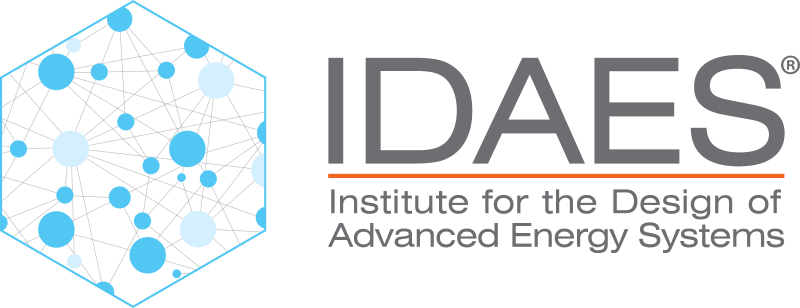IDAES Surrogates API#
The IDAES Surrogates API provides a common interface for training surrogate modelings via supported tools and populating blocks with those models.
IDAES currently supports the following surrogate trainers:
API Structure and Basic Usage#
Users may call a Python wrapper for an available surrogate tool by passing variable data, labels and bounds, along with tool-specific settings. The API supports the workflow in the following sections.
Preparing Data For Training#
First, users must load or generate a dataset to train against, typically as a Pandas DataFrame with column labels. In best practice, the input variable columns are on the left and the output variable columns are on the right. For example, to read data from a CSV file:
# there exists a data file called data.csv
import pd
data = pd.read_csv(r'data.csv') # load training data
input_data, output_data = data.iloc[:, :2], data.iloc[:, 2:] # 2 outputs
input_labels, output_labels = input_data.columns, output_data.columns]
Sampling
If desired, users may sample additional points or perform a training/validation split via IDAES Sampling tools within PySMO. Note that sampling tools within PySMO are independent of surrogate training within PySMO, and may be called regardless of trainer selected. For example, to define training and validation datasets:
from idaes.core.surrogate.sampling.data_utils import split_training_validation
n_data = data[input_labels[0]].size # get the number of data points
data_training, data_validation = split_training_validation(data, 0.8, seed=n_data) # in this case, randomly separate 20% of the data for training and 80% of the data for validation
Training Surrogates#
Once the training data is defined, users call the desired trainer method (AlamoTrainer, PysmoPolyTrainer, PysmoRBFTrainer, PysmoKrigingTrainer) to return a SurrogateTrainer object that is ready to train. For example, an AlamoTrainer object is created as below:
trainer = AlamoTrainer(input_labels=input_labels, output_labels=output_labels, training_dataframe=data_training)
Similarly, a PySMO RBF PysmoRBFTrainer object would be created as below:
trainer = PysmoRBFTrainer(input_labels=input_labels, output_labels=output_labels, training_dataframe=data_training)
Trainers allow their own configuration options, which alter the regression or file behavior and belong to the trainer’s CONFIG block. For example, ALAMO supports a configuration option for allowing linear basis functions:
trainer.config.linfcns = True
Once the SurrogateTrainer is fully defined, calling trainer.train_surrogate performs regression and returns the model results as a dictionary object named trainer._results. This dictionary contains generated Pyomo model expressions in trainer._results[‘Model’].
Alternatively, users may train a TensorFlow Keras neural network model. Users should refer to the specific documentation in the table of contents at the top of this document for details on implementing each of the five supported training tools.
Building an IDAES Surrogate Object#
To add the model to an IDAES flowsheet, the SurrogateTrainer object needs to be transformed into an IDAES SurrogateObject object. This is done by calling an appropriate method (AlamoSurrogate, PySMOSurrogate, KerasSurrogate) and passing the generated surrogate expressions, along with variable labels and bounds. For example, an AlamoSurrogate object is created as below:
surr = AlamoSurrogate(expressions, input_labels, output_labels, input_bounds)
A similar object can be created for PySMO or Keras by replacing AlamoSurrogate with PySMOSurrogate or KerasSurrogate.
Flowsheet Integration#
After generating an IDAES SurrogateObject, the models may be combined with other IDAES method to assess and run the models.
Visualizing Surrogate Models#
Visualizing Surrogate Model Results
Once the models are trained, users can leverage IDAES Visualization tools to assess the model fits. For example, the following code generates 2D scatter, parity and residual plots for all output variables in the surrogate model and prints the plots to PDF:
from idaes.core.surrogate.plotting.sm_plotter import *
surrogate_scatter2D(surr, data_validation, filename='scatter2D.pdf')
surrogate_parity(surr, data_validation, filename='parity.pdf')
surrogate_residual(surr, data_validation, filename='residual.pdf')
Saving/Loading Surrogates and Populating Surrogate Blocks#
The IDAES Surrogates API offers simple methods to export/import trained surrogates and add them to IDAES flowsheets. After creating a SurrogateObject, calling save_to_file() on ALAMO and PySMO surrogates or save_to_folder() on Keras surrogates serializes the models to JSON. Then, users may load the surrogates into any script or flowsheet using the load_from_file() call for ALAMO and PySMO surrogates or load_from_folder for Keras surrogates. Keras neural networks are complex with model weights, training parameters and metadata, and as such require a folder of files rather than a single file when serialized. For example, to save and load an ALAMO SurrogateObject:
surr.save_to_file('alamo_surrogate.json', overwrite=True)
alamo_surrogate = AlamoSurrogate.load_from_file('alamo_surrogate.json')
Then, the surrogate may be added to an IDAES SurrogateBlock:
m.fs.surrogate = SurrogateBlock()
# define inputs and outputs as lists of Pyomo Var objects
m.fs.surrogate.build_model(surrogate, input_vars=inputs, output_vars=outputs)
The surrogate must be able to find a list of Pyomo variable objects corresponding to the model input and output variables, and will automatically link the flowsheet variables to the model expressions. For a detailed demonstration of training, visualizing, optimizing and comparing available surrogate trainers, see the example [ML/AI Best Practices: “Selecting Surrogate Model Form/Size for Optimization”](IDAES/examples-pse).
